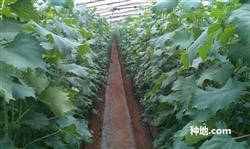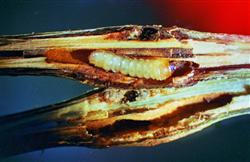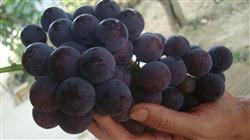How to manage growing grapes in greenhouse

How to manage growing grapes in greenhouse? Ask for advice greenhouse grapes listed early, can be listed two months in advance, supplement the off-season supply of fruits, high unit price, can obtain high yield and high efficiency, with an average annual income of 20,000-30,000 yuan / mu, is a good way to get rich in rural areas. The cultivation techniques are introduced as follows: 1. Variety selection. Through experiments all over the country, the varieties suitable for greenhouse cultivation are Jingya, Jingxiu, Fenghuang 51, Jingyou, Zhana and Jufeng. The common characteristics of these varieties are short dormant period, high yield, high temperature resistance, storage and transportation resistance, short fruit development period, early ripening, moderate growth, disease resistance and easy management. 2. Planting and establishing the garden. The selection of annual robust cutting seedlings requires more than 20 main and lateral roots, root length more than 15 cm, stem diameter more than 1 cm, and 4 Mel 6 full buds. The planting density varies with varieties, site conditions, shaping methods, seedling resources and other conditions. General hedgerow shaping, the row-plant distance is 1.2mur1.5m × 0.5m, and about 1000 plants are planted per mu. After the plant spacing of the planting row is determined, it is necessary to draw grooves to improve the soil, apply sufficient base fertilizer, and carry out high-standard garden construction in order to obtain high benefits. Generally, the planting trough is 50 per cent deep and 80 centimeters wide, and 5000 kilograms of farm manure is applied per mu. When trenching, the topsoil is separated from the subsoil, and then the topsoil is backfilled first, and then the subsoil is filled, and organic fertilizer is applied layer by layer. During the planting period, the method is the same as that of conventional tree planting. 3. Management in the current year. After the seedlings survive, promoting the robust growth of seedlings is the basis for achieving high quality and high efficiency of early fruit, so we should pay attention to the following points: ① shaping and pruning. Choose and retain the main vine in time. Because of the high planting density, the greenhouse grape is very different from the traditional pruning method, which generally adopts the single dragon dry pruning method, that is, only one main vine is left after the seedling sprouts. The principle of fixing the vine is to keep the strong without leaving the weak, and erase all the superfluous buds. When the new tip of the main vine grows to 80 cm, pick the heart for the first time, and then pick the heart for every 30 cm, leaving 1 Rue 2 leaves for the auxiliary shoot. And tie the vine on the pole in time, generally tie it once in 30ml and 40cm, and remove the tendrils. ② strengthens fertilizer and water management. Timely topdressing available nitrogen fertilizer to raise seedlings after seedling survival, more phosphorus and potassium fertilizer should be applied in autumn, leaf fertilizer should be sprayed at the same time, pay attention to a small number of times. Base fertilizer was applied early in September. In case of drought in the growing season, water should be watered in time, and pay attention to drainage in the rainy season. In addition, do a good job in the prevention and control of diseases and insect pests. 4. Build and buckle the shed. From September to October, a greenhouse was built on an one-year-old densely planted vineyard. It can be harvested and listed in the early summer of the following year. The northern area is a solar greenhouse with a micro-arch in the east-west direction and a rear wall in the north. The span is 9 meters and the length is 50 meters. The back wall and the two gables are made of brick and earth, with a thickness of 50 meters, a height of 2.5 meters, a ridge height of about 3 meters, and a distance of 1.2 meters from the back wall. The pillar is reinforced concrete column, the frame material is bamboo and wood, and the back is covered with 50 cm thick corn straw, compacted with soil. The Yangtze River basin is a plastic greenhouse, arched from north to south, with a span of 5 meters, a length of 30 meters and a height of 3 meters. Bamboo and wood, cement preform and steel pipe can be used as the skeleton. Greenhouse films are made of PVC drip-free film with good light transmission and thermal insulation, which are pressed into the soil around. The solar greenhouse is 5 meters away and leaves a vent with a length and width of 0.8 × 0.5 meters, covered with plastic film or hand-drawn straw curtains. At that time, the film will be fastened on the greenhouse and the new film will be used every year. Grapes begin to dormancy from fallen leaves and generally complete natural dormancy in about 2 months. The greenhouse can still be warmed up after the completion of natural dormancy. From north to south, the time of grape defoliation is from the end of October to the end of November, and the corresponding withholding time is from mid-late December to late January. 5. Temperature management in the shed. Generally speaking, before heating up, the water is poured forward, covered with plastic film to preserve soil moisture, and then heated up. The temperature in the shed should be gradually increased, which can be divided into five stages. Before ① germination: daytime temperature 15 ℃, night 5 ℃ 6 ℃; ② germination to pre-flowering: 18 ℃ during day, 6 ℃ at night; temperature at flowering stage of ③ is slightly higher, 25 ℃ during day, 8 ℃ at night; ④ falls to fruit expansion stage: 25 ℃ during day, 1518 ℃ at night ⑤ fruit coloring to harvest period: no more than 30 ℃ in daytime, 15 ℃ at night, enlarge the temperature difference between day and night, promote fruit coloring and sugar accumulation. 6. Humidity control in the shed. The air humidity in the shed should be controlled at about 90% from mulch to germination, 60% from germination to flowering, 50% from flowering to fruit expansion, and 50% from later to harvest. Soil moisture, the relative water holding capacity of soil should be kept at 60% from greenhouse to harvest. In different phenological periods, the water requirement during sprouting and fruit expansion is higher, which should be controlled in the range of 70% and 80%. In the process of fruit growth and development, the change of soil water content should be avoided as far as possible to prevent fruit cracking. 7. Fertilizer and water management. After fruit harvest every year, apply sufficient base fertilizer, apply 3000 Mu 4000 kg, compound fertilizer 50 Mu 100 kg, draw trough to apply deeply. Every year, urea 30 kg and ternary compound fertilizer 50 kg were used for the first topdressing in the budding stage, 40 kg urea for the second topdressing after falling flowers, and 50 kg potassium sulfate for the third time in the early stage of coloring. During the fruit growth period, the leaves were sprayed with fertilizer 3mure for 5 times, and 0.3% potassium dihydrogen phosphate, potassium sulfate or potassium amino acid were used to promote coloring and improve quality. It should be irrigated in time in case of drought, especially after removing the shed in summer, and should be irrigated once after applying base fertilizer. 8. Shaping and pruning. In the first year, the winter shears should be dried from 80 cm. Seven fruit-bearing branches sprouted on it, and one ear was left on the other shoot except for the lowest one. The weak shoot leaves no ear, and the accessory spike and spike tip are removed at the same time. After fruit setting, trimming ears, thinning small grains and too many grains, leaving 60 grains per panicle and 40 grains in the giant peak of large fruit type, the average yield per panicle is 400 grams, the plant yield is about 2 kilograms, and the yield per mu should be controlled at 2000,500 kilograms. The yield is too high and the quality will decline. In the second year, the winter shearing leaves a short cut of 1 cm above the reserve branch, and the reserve branch is pruned according to the medium-long shoot, which is used as the fruiting mother branch next year. In the third year, and so on, the fruiting branches were renewed every year to keep the fruiting position stable. The temperature in the greenhouse is high, the humidity is also high, and the light is poor, which is easy to cause futility. Therefore, the key point is to do a good job of summer shearing, timely wiping buds, removing tendrils, fixing branches, and binding. As a result, 8 leaves were left in the upper part of the flower spike to remove the heart, and the lower accessory shoots were erased. After coring, the elongated branches are plucked with 7 leaves for every 6 murals, and the auxiliary shoots are left with 2 leaves for coring to control growth and enrich flowers, fruits and branches. In order to improve the fruit setting rate, 0.3% borax solution should be sprayed at the early flowering stage without affecting the temperature. 9. Pest control. Grape diseases and insect pests in the greenhouse are relatively light, but can not be ignored, comprehensive control should be carried out, after defoliation combined with winter pruning, cut off disease and insect branches, remove fallen leaves and weeds in the garden, and reduce the overwintering base of diseases and insect pests. The main diseases are house blight, powdery mildew, brown spot, gray mold and so on. Prevention and cure method: spray Baumei 3Mel 5 degree stone sulfur mixture once before germination, spray 70% methyl topiramate 800Mel 1000 times twice every 15 days before anthesis. Spray 50% carbendazim 800 times solution and lime half-dose 200 times Bordeaux solution every 15 days after flowering. Insect pests mainly control thrips, red spiders and harmful mites. It can be sprayed with 2000 times of 20% dimethoate and 1000 times of omethoate. Remove the film after fruit picking, and control the diseases and pests in the open field after removing the film. Click to see more grape planting techniques click to see more fruit planting techniques
- Prev

Cherry tree planting: how to control diseases and insect pests in different periods of big cherry trees?
How to control diseases and insect pests in different periods of big cherry trees? Please introduce the control methods of diseases and insect pests in different stages of big cherry. The main diseases and insect pests of big cherry are mulberry white scale, green bug bug, leaf miner, perforation disease, leaf spot disease, root cancer disease, gum disease and so on. The following introduces the control methods of diseases and insect pests in different stages of big cherry for reference: 1. Cherry.
- Next

How about Hutai No. 8 grape?
How about Hutai No. 8 grape? Where is Hutai No. 8 grape suitable for planting and how to plant it well? Hope that experienced friends can help introduce the data and planting techniques of Hutai No. 8 grape through the farming network. The following is a list for netizens' reference. Hutai No. 8 grape variety characteristics: Hutai No. 8 grape.
Related
- Moge, come on! The staff of the peasant association in the producing area of cantaloupe were frightened when the crowd gathered.
- Causes and Solutions of low Fruit setting rate of Apple
- Symptoms and control measures of passion fruit virus disease
- Fruit growing lesson: how do apple orchards keep high yields?
- Can you build orchards in the mountains? What are the pros and cons?
- How to manage the coloring period of Crisson grape?
- This paper introduces the processing technology of two kinds of fig products.
- How much is a month for retired teachers in rural areas by 2020?
- How can strawberry planting increase sugar content? We should pay attention to management in many aspects.
- What are the cultivation techniques on how to improve the yield of golden fruit?

